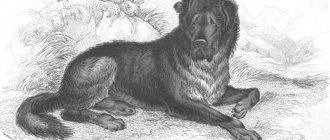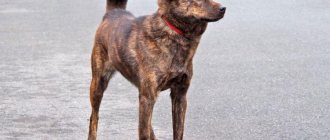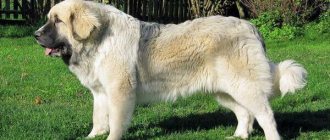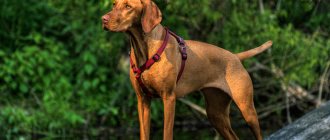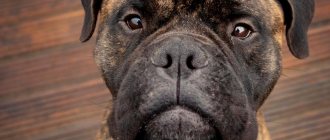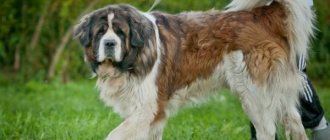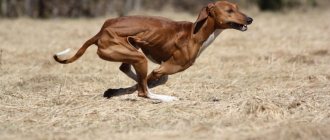| Origin: | England |
| Usage: | watchman, companion |
| Color: | apricot, brindle, fawn |
| Dimensions: | males 76 cm and 68 – 113 kg, females 70 cm and 54 – 91 kg |
| Lifespan: | 6 – 10 years |
A good-natured giant - this is how the mastiff can be briefly described. The ancestors of these loving and devoted dogs hunted lions and bears, participated in gladiator battles and dog fights, supervised slaves and fought against legionnaires. But today the English Mastiff has lost its ferocity. He loves his family, and more than anything else he loves to lie on the couch. The only thing left in the pet from its ancestors is its protective and watchdog qualities. If he feels threatened, he will immediately turn into a fearless defender.
Description of the breed
The English Mastiff, whose standard has been recognized by major canine organizations (FCI, UKF, FCI), is a strong, confident dog. She should be calm, courageous, wary, but without aggression, and treat strangers.
The minimum weight of an English Mastiff for a female is 54 kg, for a male – 68 kg. On average, a dog weighs 90 – 100 kg. At the withers it reaches 70–80 cm.
Frame
The description of the breed presents a strongly built dog with well-developed muscles. The sizes are large, the bones are wide. The dog is longer in length from scruff to tail than in height. The chest is wide, deep, its volume exceeds the height at the withers by 1/3. The dog gives the impression of great strength. Even the photo of an English Mastiff looks impressive.
The tail is sickle-shaped, large, tapering towards the end. When the dog is calm, it keeps the rod lowered, and when moving it raises it up to the back, but not higher.
Head
Square, with jowls and folds on the muzzle. When the pet concentrates, deep wrinkles gather on its forehead, giving it a menacing appearance.
The nose is large and black. The eyes are set wide apart, dark or hazel in color. The ears are dark or black, drooping, thin and soft, with rounded tips. The teeth, especially the fangs, are powerful. A direct or reverse scissor bite – with the lower jaw protruding slightly forward.
Limbs
Straight, set wide apart, parallel to each other. The joints are developed. The paw pads are balled up, arched, with black nails.
Coat and color
The coat is short, dense, and harsh. The undercoat is soft and dense. The English Mastiff dog breed has the following colors:
- apricot (red);
- fawn (deer);
- dark brindle - the so-called black English mastiff.
An accurate idea of the color will be formed after viewing a photo of an English mastiff.
Regardless of color, there should be a black mask on the face, and the ears and nose should be dark.
The breed standard classifies a small white spot on the chest as a fault. Excessively large white spots on the body, the absence of a mask or its asymmetry are disqualifying faults.
Application and training
English thugs are taken in as companions. But they are also excellent watchmen and security guards. Moreover, they do not need courses in protective guard training: they protect the territory and their owners instinctively. But, if you wish, you can take classes.
The animal's appearance alone will scare off ill-wishers. It’s not for nothing that even owners of six-month-old puppies are asked “do you happen to have a horse?” In addition, dogs are wary of strangers: they stand between the owner and the stranger, and do not leave until they are sure that their person is safe.
OKD will be required. English Mastiff puppies should undergo this test at 6 – 8 months. The breed's characteristics describe the dogs as intelligent, obedient and diligent. Having learned the command, they will carry it out unquestioningly. But the dogs do everything slowly, so you have to be patient.
History of the origin of the breed
The exact origin of the breed is not known, although it is based on a version in which the direct ancestor of the English Mastiff was the Tibetan Mastiff. The popularity of the latter led to the fact that the dog came to Great Britain, where, through the process of evolution and crossing, the appearance we know appeared.
Throughout their history, mastiffs were used as fighting dogs - they were loved to be used in gladiatorial fights and on the battlefields. They have proven themselves excellent as beaters of large animals. They were valued for their protective qualities - they guarded slaves and protected their owners. At the moment, most of these functions are not required, so the English Mastiff has ceased to be a “weapon” and an instrument of bloody entertainment. There is practically no cruelty or aggression left in him.
Although the English Mastiff is no longer considered an endangered breed and is widespread throughout the world, this was not always the case. The widespread interest in dogs that burned in Ancient Rome and the Middle Ages faded to almost nothing by the 19th century. Only 14 individuals survived after the Second World War; this was the brink of rapid extinction, after which a representative of the breed could only be seen in ancient bas-reliefs, drawings, and black and white photographs. Fortunately, activists appeared and thanks to them they managed to save the species.
What the formidable mask hides: character traits
The intimidating appearance and size of English mastiffs scares away novice dog breeders. But inside the formidable dogs hide loving and devoted friends.
Pets are harmless. They adore all family members. Animals are not touchy; they subtly sense people’s moods and understand when they are out of sorts. Dogs do not tolerate cruelty, but they will forgive rudeness if the owner accidentally loses his temper.
But outsiders need to be careful. Mastiffs will not harm family members, but are extremely wary of strangers. You should not go hugging a dog who is calmly walking next to the owner - the pet may perceive this as aggression or a threat to the owner. And she will fiercely defend him and herself.
Frequent diseases and problems
The most common diseases of English Mastiffs are:
- allergy;
- cherry eye;
- demodicosis;
- arthrosis;
- inversion/inversion of the eyelid;
- glaucoma;
- arthritis;
- joint dysplasia;
- leukemia;
- obesity;
- pyoderma;
- atrophy or dysplasia of the retina;
- cardiomyopathy;
- cataract;
- bone tissue oncology;
- bloating;
- pulmonary stenosis;
- heart murmurs;
- urolithiasis;
- gonarthrosis;
- hereditary von Willebrand disease (blood clotting disorder).
English mastiffs are perfect four-legged pets for home and apartment. They can become loyal and devoted friends, real guards and protectors of the owner. To raise a good-natured and open dog, you need to properly care for, feed, train the dog and give it due attention.
Dogs can fall in love
When a dog comes into contact with people or other dogs, oxytocin, the love hormone, is released in its brain, this process is identical to what happens in the human brain when hugging or kissing.
The largest dog that ever lived is the English Mastiff.
The English mastiff Zorba, born in 1981, was the largest dog in history. Its mass was more than 155 kg, and its length from the tip of its nose to the tip of its tail was 251.5 cm.
The Saluki is the oldest known dog breed.
The Saluki is considered to be the oldest dog breed known to man. In Ancient Egypt they belonged to the royal families. They were treated with reverence during life, and were even mummified after death as pharaohs.
Relationships with children and animals
A well-mannered mastiff does not show aggression without a reason. The key word is “well-mannered.” The puppy is socialized from the first days of life, otherwise he will become withdrawn, extremely distrustful, and even cruel.
At first, breeders teach them how to interact with people. They pet the puppies as often as possible, talk to them, and carry the babies in their arms.
The owner’s task is to introduce the puppy to possible situations and living beings with which the pet will have to come into contact. He is taught to communicate with other people, dogs and other pets.
But the main thing is that the dog must learn the rules of behavior with children. If an English Mastiff dog gets to know them as a puppy, she will allow the kids to do anything with her - pull the ears, tail, pull back the jowls and even ride on herself.
English Mastiffs are not recommended for families with children under 7 - 12 years of age. Animals will not harm children on purpose. But due to their large dimensions, they can accidentally push, hit or crush a child.
Mastiffs get along well with other dogs, especially dogs of the same breed. Conflicts sometimes arise between male dogs, but they are easy to stop.
It’s more difficult with cats and other pets. Dogs are not cattle dogs; they do not have an innate loyalty to small animals. They get along together if they grew up side by side. But bringing a kitten into a home where there is an adult mastiff is a mistake. Dogs rarely take a new pet calmly and can easily devour the baby.
Character of the breed
If earlier this breed of dog was known for its complex character and high level of aggression, now they have become completely different.
Despite its fighting appearance, the dog is very kind and smart. They are quite capable of making independent decisions, so it is worth instilling basic commands in her from an early age. Basically, the English Mastiff tries to please its owner. Realizing that she is praised for certain actions, she will repeat them. This is exactly what the training of the English handsome dog should be based on.
Mastiffs are owners. Their own territory is important to them, so you must allocate a corner for them in an apartment or house. They will also regularly inspect the property; if something alerts them, they will inform the owner about it. They love to explore other people's territories, so during a walk it seems that they, like Sherlock Holmes, are looking for traces of crimes.
In order to please the owner, to whom they are very attached, they may resort to mastering unusual techniques for attracting attention: bringing slippers, a blanket, throwing their paws over their shoulders when meeting in the evening, etc.
If something is moved from a permanent place to another, the mastiff will try to fix it. In this regard, the dog is very pedantic.
They do not show aggression. That is why they make an exceptionally aristocratic impression. They do not like to be participants in noisy events and bustle, preferring to quietly retire. They love to play, but in moderation. Moreover, it must be taken into account that their speed is much higher than human speed.
To protect family members or puppies, they prefer not to rush at the offender, and not to let him get close. A massive dog is quite capable of instilling fear even with a growl.
They get along well with children and other pets. But it is important to ensure that they do not overstep the boundaries, especially with regard to the dog’s place. There should be no other people's things there.
Nutrition and care
The English Mastiff, whose breed characteristics speak of its calmness, does not require fuss about its maintenance. Although the fur falls out a lot during the molting process, it is not so noticeable due to its length. To keep it shiny, it is enough to feed your pet well, and also brush it twice a week.
Take regular care of your ears and eyes, because bacterial infections quite often affect these organs.
The mastiff's folds should be wiped every day with a damp pad or viscose cloth. Otherwise, you can easily develop a skin disease.
Excessive salivation may require the dog owner to treat the neck and mouth. The dog's nails are trimmed regularly, otherwise the apartment will be very noisy when the dog is fermenting.
It is probably difficult to keep this dog just because of the food. Large representatives of this breed must consume large amounts of food. Moreover, its quality should be at a high level: proteins and fats (from natural meat, fish, chicken, dairy products, boiled eggs), complex and simple carbohydrates (porridge, vegetables, fruits if possible). At the same time, you still need to identify which foods can cause excessive gas formation and remove them from the dog’s diet.
Such difficulties usually lead to the fact that most breeders prefer to provide professional food. It works out cheaper too.
Such dogs do not need long walks, which is very convenient in an urban environment.
When equipping your personal space, it is better to use bulky items, for example, a children's mattress. This will create maximum comfort for the English aristocrat.
Nuances of maintenance and care
Pets are easy to care for, but expensive to maintain. The dogs are large, they need a lot of space and a huge amount of food. In addition, they are prone to numerous diseases, so you will have to budget a certain amount for veterinary services.
A private home is suitable for mastiffs. You can keep them in an apartment if it is large, with spacious rooms and not crowded with furniture - “fat ones” need space to maneuver.
You can keep a dog in an enclosure only in the warm season. At temperatures below 0°C it freezes. But constant life on a leash is not for him: it is vital for a pet to be part of a family and constantly in contact with people.
Pets are not suitable for squeamish people. They carry a lot of dirt on their paws into the house, drool profusely, snore loudly (like all brachycephalic breeds) and pass gas.
The advantage of mastiffs is silence. They rarely bark. That's why the neighbors are in a multi-story building. They will only hear a loud stomp from above.
Grooming
Easy care. Need to:
- brush the dogs every day with a massage brush - due to the short hair, the procedure will take about 15 minutes;
- brush your teeth weekly;
- once every 7-10 days, examine and clean your eyes and ears;
- Trim the nails every 2 weeks if they do not grind down on the asphalt on their own.
Bathing
Washing is problematic. Pets need to be bathed once a quarter, but every bathing day is a test for the owners.
English Mastiffs do not like to wash themselves. Weight also plays a role: dragging a 100 kg animal into the bath is a problem. In addition, they are difficult to soap and pour water on due to their large growth.
Bathe animals with hypoallergenic shampoo for short-haired dogs. After the bath, make sure that dogs do not lie in drafts.
Paws are washed after every walk. At the end of the meal, wipe the folds on the face from food debris.
Walk
The owners of English mastiffs are not familiar with the situation when the dog runs up to them with a leash in its teeth and asks to go for a walk. The English Mastiff dog breed is famous for being a homebody. Their favorite pastime is lying around in a cozy, warm place. Therefore, the first thing you have to do is buy a bigger sofa.
But dogs need physical activity. Running and playing sports are not suitable for them, but leisurely walking for an hour or two is the best option. It is better to walk your pet over rough terrain to train muscles and strengthen joints.
Prepare a bowl, and a bigger one: feeding features
Nutrition is a stumbling block. Dogs literally eat buckets. The owners joke that it is easier to feed a piglet than a mastiff.
Feeding standards for puppies of different ages are as follows:
- at 1 – 3 months – 5 times a day, 0.5-0.8 l;
- at 4 – 6 months – 3 – 4 times a day, 1-1.5 l;
- at 7 – 8 months – three times a day, 2-2.5 l;
- from 8 months – 2 times a day, 3-5 liters.
Mastiffs themselves do not agree with the standards. They don't mind eating 2-3 times more. Animals will have to be controlled, because... they are prone to obesity.
You can feed your pets with ready-made super-premium or holistic-class dry food or natural food. Owners prefer the second option - it is cheaper.
“Natural” should consist of lean meat, offal, fermented milk products, cereals, and vegetables. 1 – 2 times a week give raw eggs, moslaks (large spongy bones), fruits, treats (cheese, dried meat, crackers). You can't salt food.
Mastiffs are given chicken with caution due to possible allergies. There should be a lot of fermented milk products in the diet. Vitamin complexes and mineral supplements are regularly taken in courses to strengthen the bones and joints.
Nutrition
An adult animal should be fed twice a day, puppies - from 3 to 6 times. A sexually mature dog needs:
- 1-1.5 kilograms of dry food daily, for example, “holistic” class;
- meat products (beef, chicken, lamb);
- sea fish and offal (no more than once every 7 days);
- cereals (rice, buckwheat);
- vegetables (zucchini, cabbage, carrots).
It is prohibited to include in the diet:
- other cereals, except those allowed;
- onion;
- potato;
- peas;
- sweets;
- I'm eating from the table.
Health
A pet lives on average 8 – 10 years. But with good care and the absence of congenital pathologies, English mastiffs can live up to 15–17 years.
Dogs have strong immunity. They rarely catch colds and easily resist infections.
Diseases
The English Mastiff dog breed is not very healthy. She has many pathologies caused by heredity and type of constitution:
- dysplasia of the elbow and hip joints;
- numerous eye problems that lead to blindness;
- demodicosis;
- pyoderma;
- epilepsy;
- hormonal disorders;
- diseases of the cardiovascular system;
- arthritis;
- allergies;
- urolithiasis disease;
- cherry eye;
- inversion or inversion of the eyelid;
- pathologies of the respiratory organs.
Vaccinations
Dogs are vaccinated as standard. Up to a year, the puppy needs 4 vaccinations: at 2 months, followed by revaccination after 3 weeks, at six months and at a year. In the future, injections are given annually.
Dogs are vaccinated against:
- rabies;
- plague;
- adenovirus;
- parvovirus enteritis;
- hepatitis A.
Depending on the epidemiological situation in the region, the veterinarian will recommend additional vaccination against other dangerous viruses.
Photos of the largest dogs in the world
In our gallery you can find photos of the largest dogs in the world. Incredible power!
Vladimir Putin was given a six-month-old puppy of the rare Taigan breed. The President of Kyrgyzstan Sooronbai Jeenbekov made a generous gift as a sign of respect to Vladimir Vladimirovich: puppies of this national aboriginal breed are usually given to the most honored guests of the country. The dog has already been given the nickname Sherkhan, and cynologists unanimously speak of Taigans as unique hunting dogs.
The breed has not yet been recognized by the International Cynological Federation, but it already has every chance of becoming a unique specimen in the Red Book, as it is on the verge of extinction. The breed is more than 12,000 years old, so these dogs have excellent health and are extremely resistant to heavy loads. One of the relatives of the Taigan is the Scottish deerhound - the Darkhound - one of the largest dogs in the world.
Deerhound (Scottish Deerhound)
The Deerhound is a rather thin dog (up to 45-46 kg), but thanks to their high height (from 71-76 cm), they deserve to bear the title of giants of the canine world. The advantage of the breed is its speed, which can compete with the speed of a deer. Due to this, deerhounds are used when hunting deer without weapons.
9 Largest Dog Breeds in the World
Leonberger
The name of the breed originates from the German city of Leonberg, on whose ancient coat of arms a lion was depicted. There is an opinion that the breed was bred precisely as a recognizable symbol of the city.
Several largest breeds had a hand in the creation of the Leonberger: St. Bernard, Newfoundland and Pyrenean Shepherd. The proud, handsome dogs that resulted from many years of crossbreeding not only became one of the largest breeds, but also earned a reputation as an excellent “family dog.” A calm and even gentle character, sociability and goodwill towards all family members are the distinctive qualities of the Leonberger. It is this breed that the Hollywood actor of Scandinavian origin Alexander Skarsgård adores.
Newfoundland
This good-natured aristocrat came to Russia from the Canadian province of Newfoundland, bordering the waters of the Atlantic. It is not surprising that representatives of this breed are excellent swimmers. And not only that - on their native island, they were given the responsibility of pulling nets with fish out of the water, carrying heavy objects over fairly long distances, and even working as a nanny.
The quiet nature of the Newfoundland ensured that the dog would not capsize the boat. Some owners claim that Newfoundlands are able to determine which direction the coast is when the horizon is shrouded in fog.
The Newfoundland is a huge dog, but not record-breakingly large: the average height is 66-61 centimeters, weight is 54-68 kilograms. However, the largest Newfoundland known weighed 117 kilograms, and its length from tip of nose to tail was 182 centimeters.
Tibetan mastiff
In general, there are several varieties of mastiffs, and almost each of them deserves to be included in the top largest dogs. The Tibetan Mastiff is still shrouded in an aura of mystery, because it is one of the most ancient, rare and expensive breeds in the world.
The first mentions of this breed in literature date back to the 4th century BC. Aristotle admired the flexibility, strength and endurance of these dogs. In the old days, one Tibetan mastiff was exchanged for a pack of 20-25 greyhounds - their hunting skills were so highly valued! The “migration” of this breed to the New World is also surprising - in the second half of the 20th century, the Dalai Lama himself gave such a puppy to President Eisenhower.
"Planet of Dogs": Tibetan Mastiff
Nowadays, due to the mystery of this breed, many people far from cynology have the impression that the Tibetan Mastiff is the largest dog in principle. But this is not so, and to be convinced of this, it is enough to visit the exhibition (if you are lucky, and this rare breed will be present at it). The weight of these dogs can vary from 60 to 80 kilos, height is about the same - from 60 to 77-78 centimeters (depending on gender).
Irish Wolfhound
One of the tallest dogs in the world, the Irish Wolfhound has a long history of greatness. Even four centuries BC, the Celts used them (more precisely, their ancestors, the Celtic greyhounds) for hunting. The outstanding size, strength and speed of Irish wolfhounds marked the beginning of mass demonstrative baiting of wild animals with their help. Unfortunately, this also led to a reduction in the breed's population to a critical level.
By the beginning of the 19th century, the breed had practically disappeared, and only thanks to an enthusiast named Richardson, who traveled the length and breadth of the British Crown Islands in search of an “old-type” female Irish Wolfhound, today we can enjoy these curly, muscular paws.
Pyrenean Mastiff
Although this breed is more than three thousand years old, the Pyrenean Mastiff was officially recognized only in 1946. According to experts, this breed was bred by the ancient Phoenicians - primarily as a shepherd and watchman. Males reach 80-81 centimeters in height, females - 72-75. The average weight fluctuates around 70 kilograms.
“Gentle giant” is what their owners call Pyrenean mastiffs. This dog is truly caninely affectionate and is very patient with the antics of the youngest members of the family, although it can often unintentionally knock a child down during play. At the same time, in the presence of strangers, the Pyrenean Mastiff always remains on guard. The dog understands perfectly well that one type of dog instills fear, so usually when communicating with strangers it limits itself to barking, but does not proceed to “combat” actions.
Saint Bernard
Saint Bernard is undoubtedly one of the strongest, bravest and kindest dogs. Male St. Bernards can grow up to 90 centimeters at the withers. The curious history of this breed is known to many. Back in the 9th century, monks living in a monastery hidden in the mountains of Switzerland brought Tibetan mastiffs from Asia. Over the years of crossbreeding with European breeds, they developed a faithful companion for dangerous mountain journeys.
The dog was distinguished by thick hair that saved it from frost and wind, an excellent sense of smell that allowed it to find people buried under an avalanche, easygoing behavior and excellent trainability.
One of the most famous pets of the Saint Bernard Monastery is Saint Bernard Barry, who at the beginning of the 19th century found a boy buried in the snow, warmed him with his tongue and carried him to the monastery on his back.
German dog
Great Danes, recognized giants of the canine world, do not even have an upper height limit in the breed standard: female Great Danes should not be lower than 72 centimeters, and boys - 82. The tallest dog in the world, the Great Dane George, which we will discuss, belonged to this breed a little lower.
A powerful, graceful body, nobility expressed in every movement, combined with innate delicacy make the Great Dane an excellent life partner for responsible, active people.
The pedigree of the Great Dane is so closely related to the pedigree of the English Mastiff that debate about which of these two breeds is larger continues to this day.
The largest dog breed in the world is the English Mastiff.
This ancient English breed has the status of the largest among the variety of canine species. The standards for this breed are as follows: males reach approximately 0.9 meters at the withers and weigh approximately 100-110 kilograms. However, the largest English mastiff, Hercules, grew to 94 centimeters and weighed as much as 155 kilograms.
English Mastiff trying to climb onto the sofa
Despite its awe-inspiring size, the English Mastiff has a good-natured disposition and is a wonderful companion.
Mating
The first heat in bitches occurs at six months to a year. But it is too early to breed a dog at such a young age. A female no younger than 2 years old can bear and give birth to healthy offspring.
They bring the dogs together in the dog's territory. Before mating, it is better to feed and walk the animals. There are usually no problems with conception.
Pregnancy lasts 63 – 70 days. The volume of portions is increased, but the bitch is not overfed - excess weight makes childbirth difficult.
English Mastiffs are loving parents. Sometimes too much. They may lick the babies too intensively, or, trying to warm the babies, suffocate them with their bodies. The dog's mother is monitored so that she does not torture the babies with excessive care.
How to choose a puppy
English Mastiffs are a popular breed. They are bred by everyone who is not too lazy and whose finances allow them to support the “big guys”. Therefore, there is a high risk of running into an unscrupulous person class=”aligncenter” width=”600″ height=”355″[/img]
To buy a healthy purebred puppy you need:
- acquire a friend only in official nurseries;
- check the pedigrees and veterinary passports of the parents, the metrics of the puppies;
- pay attention to the appearance and character of the kitten - it should be moderately well-fed, cheerful, playful, not shy or snappy, eat well, without dark plaque and pus in the ears and eyes.
Puppies are weaned from their mother at 1.5 – 3 months. Babies less than 6 weeks old cannot be sold - they still feed on milk.
How much does an English Mastiff cost?
The price of an English mastiff depends on many factors, and the average amount starts from 30,000 rubles. The price is influenced by the gender of the dog, compliance with standards, the location of the nursery, pedigree and degree of title of the parents are taken into account. Cull puppies that will not participate in dog shows are sold for a small price.
At the same time, the price of a puppy with a good pedigree and titled parents skyrockets. Here you need to decide for what purpose the animal is needed: to participate in exhibitions or just as a friend.
In any of these two cases, you will not lose, since you will have a pet that will brighten up your everyday life and become a favorite of the whole family.
How much do puppies cost?
At the poultry market or by advertisement, English mastiff puppies are sold for 6–15 thousand rubles. But these are not purebred cuties.
Breed-class pets with a pedigree cost at least 50,000 rubles, but how much a show-class puppy costs cannot be answered with certainty. Their price exceeds 100 thousand rubles. They sell pet-class treats cheaper - for 25 - 35 thousand rubles.
The best nurseries in Moscow and St. Petersburg
You can buy an English Mastiff in Russia in the following trusted kennels:
- https://www.englishmastiff.ru/englishmastiff/ – “Shulvi Rozan” became the best nursery in Russia three times;
- https://mastiffhills.ru – the breeder breeds mastiffs imported from Germany and England;
- https://www.biboshu.narod.ru/biboland/biboland.htm – breeding dogs and offspring of BiboLAND became prize-winners of major Russian and foreign exhibitions.
On the nurseries' website you can see photos of puppies and parents.
English Mastiffs are a dream for inactive lovers of large dogs. With dogs you don’t need to run outside for half a day or go through endless training courses. To be happy, they need a couple of hours of measured walks, a wider sofa and the love of their owner.
